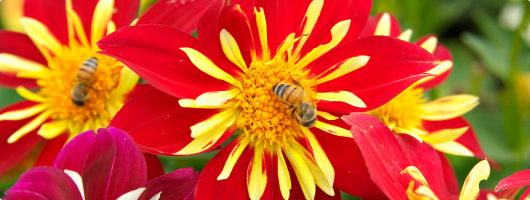Nutrition of the apiary

Food collection
At the age of around three weeks, the worker bee becomes a collector and collects nectar, pollen and propolis. Visits to the different types of plants are carried out at a specific time of day, when each plant excretes nectar or offers pollen (Percival, 1955). The collector uses the position of the sun as a guide. She imprints in her memory the projection of the angle formulated from these points: sun position, beehive and food position. By using this angle, she returns back home without wandering around. During partly cloudy days, even when the sun is hidden, bees find the sun’s exact position by the diffracted light. In days with full cloud cover, bees once again are guided by the sun, because they can see the ultraviolet light which penetrates the clouds.
It was observed that collector bees travelled up to 13,7 kilometres to collect food. Even in such long journeys, where the position of the sun changes, the worker makes the necessary adjustments thanks to her highly developed sense of time and she finds her way back home.
The collector bees make distant journeys even when there’s food in shorter distances, as long as the flowering which is further away is more attractive. They therefore increase the capacity to collect from a larger variety of flowers and they enrich the composition of the food the apiary collects. In periods where flowering is reduced, it is often observed that a worker bee clashes with a foreign bee entering her area, with the goal to stop her from collecting.

Collection, maturation and storage of honey
When the collectors of nectar return to the beehive, they deliver the nectar they carry to the bees in charge of storage -via the method of trophallaxis - who in turn they initially process it to remove some humidity and later store it in cells.
Trophallaxis
With this term we mean the exchange of food among the worker bees, through mouth-to-mouth feeding (or proboscis-to-proboscis to be more precise). This method is used by worker bees to disseminate food to the bees that are in the remote places of the beehive and to feed the queen bee and the young drones.

Nutrition of the apiary
Collection is the most tiresome and the most dangerous task a worker bee has to carry out. It is, however, of great significance for the survival of the apiary. The collected pollen provides the necessary proteins for the development of the tissues and glands of the bee.
The yearly consumption of pollen for an apiary is 15-30 kilos. Carbohydrates are found in honey. Each apiary consumes 60-80 kilos of honey per year.
Water is an essential element in a bee’s diet and is used for the rarefaction of honey, for feeding the offspring, for the cooling of the beehive and for the reduction of temperature.
Robbing: The collector bees collect honey from every appropriate source. During periods of reduced flowering, another food source could also be the stored honey found in neighbouring apiaries. Therefore, the collector bees steal honey from weak apiaries which cannot defend their supplies.

The gland system
The gland system is divided into the endocrine and the exocrine glands. The endocrine glands secrete hormones to the inside of a bee’s body and they are related to the biochemical regulation of the development and the behaviour of the bee. Exocrine glands excrete their product –pheromones, enzymes, beeswax, and venom- to the environment. The royal jelly, the venom, the invertase enzyme which transforms nectar into honey and beeswax are only but a few products of these glands. They also produce pheromones which regulate the behaviour of the entire apiary.